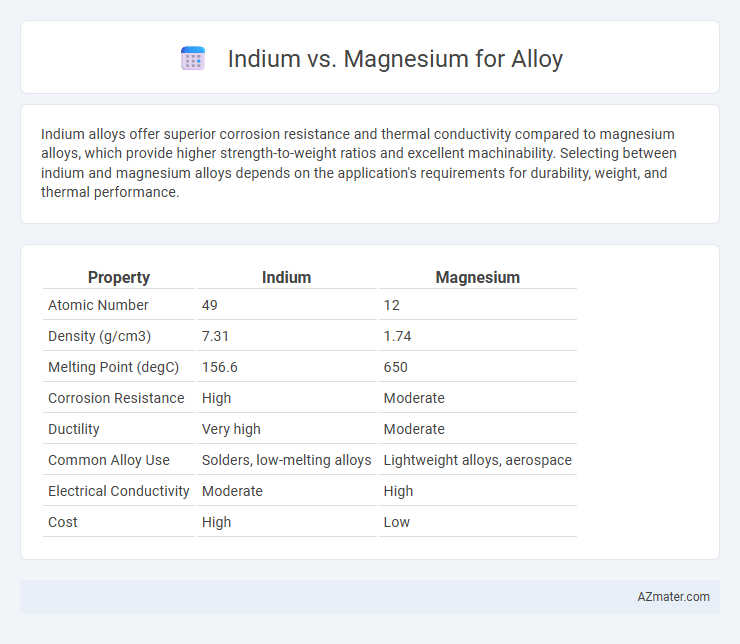Indium alloys offer superior corrosion resistance and thermal conductivity compared to magnesium alloys, which provide higher strength-to-weight ratios and excellent machinability. Selecting between indium and magnesium alloys depends on the application's requirements for durability, weight, and thermal performance.
Table of Comparison
| Property | Indium | Magnesium |
|---|---|---|
| Atomic Number | 49 | 12 |
| Density (g/cm3) | 7.31 | 1.74 |
| Melting Point (degC) | 156.6 | 650 |
| Corrosion Resistance | High | Moderate |
| Ductility | Very high | Moderate |
| Common Alloy Use | Solders, low-melting alloys | Lightweight alloys, aerospace |
| Electrical Conductivity | Moderate | High |
| Cost | High | Low |
Introduction: Indium vs Magnesium Alloys
Indium and magnesium alloys exhibit distinct properties that influence their applications in various industries. Indium alloys are known for excellent corrosion resistance and low melting points, making them ideal for soldering and coating uses. Magnesium alloys offer high strength-to-weight ratios and excellent machinability, making them preferred for aerospace and automotive components.
Chemical Properties Comparison
Indium exhibits a lower melting point (156.6degC) and higher malleability compared to magnesium, which melts at 650degC and has greater structural strength. Chemically, indium is less reactive, showing resistance to oxidation and corrosion, whereas magnesium aggressively oxidizes, forming a protective oxide layer. The differing electronegativities, with indium at 1.78 and magnesium at 1.31 (Pauling scale), influence their alloying behavior and corrosion resistance profiles.
Mechanical Strength and Durability
Indium alloys typically exhibit lower mechanical strength compared to magnesium alloys, which offer superior tensile strength and hardness essential for structural applications. Magnesium alloys provide enhanced durability through excellent corrosion resistance and fatigue performance, making them preferable for demanding environments. The combination of lightweight properties and high mechanical strength makes magnesium alloys more suitable for applications requiring long-lasting durability.
Corrosion Resistance in Alloys
Indium enhances corrosion resistance in alloys by forming a protective oxide layer that prevents further surface degradation, making it valuable in marine and chemical environments. Magnesium alloys, while lightweight and strong, typically exhibit lower corrosion resistance and often require coatings or alloying with elements like aluminum or rare earth metals to improve durability. The choice between indium and magnesium for alloy corrosion resistance depends on the specific environmental conditions and performance requirements of the application.
Weight and Density Differences
Indium alloys typically exhibit higher density, around 7.31 g/cm3, compared to magnesium alloys, which have a lower density near 1.74 g/cm3, resulting in significantly lighter materials when using magnesium. Magnesium's low density makes it ideal for applications demanding reduced weight, such as automotive and aerospace components, enhancing fuel efficiency and performance. Indium alloys, while denser, offer superior corrosion resistance and electrical conductivity, yet their weight limits their use where lightweight materials are critical.
Cost and Availability of Indium vs Magnesium
Indium is significantly more expensive and less abundant than magnesium, making it a costlier choice for alloy production. Magnesium is widely available and cost-effective due to its abundance in the Earth's crust and extensive mining infrastructure. The high cost and limited supply of indium restrict its use primarily to specialized applications rather than large-scale alloy manufacturing.
Applications in Modern Industries
Indium alloys are highly valued in electronics and semiconductors for their excellent thermal and electrical conductivity, making them ideal for soldering and heat dissipation in modern devices. Magnesium alloys dominate the aerospace and automotive industries due to their lightweight properties, high strength-to-weight ratio, and corrosion resistance, which enhance fuel efficiency and structural performance. Both metals in alloys contribute distinct advantages: indium improves electrical interfaces, while magnesium supports lightweight structural components in advanced manufacturing.
Environmental Impact and Sustainability
Indium alloys, though valuable in electronics due to their non-toxicity and recyclability, face environmental concerns from limited global reserves and intensive extraction processes. Magnesium alloys offer superior sustainability with abundant availability, lower carbon footprint during production, and high recyclability, making them preferable for eco-friendly applications. Selecting magnesium over indium for alloy manufacturing supports reduced environmental impact and enhanced resource efficiency in industrial usage.
Alloy Processing and Manufacturability
Indium enhances alloy processing by improving ductility and reducing melting temperatures, facilitating easier casting and welding in magnesium-based alloys. Magnesium alloys with indium exhibit refined microstructures, leading to enhanced machinability and corrosion resistance during manufacturability stages. In contrast, pure magnesium alloys offer lightweight properties but often require more complex processing due to higher reactivity and brittleness.
Future Trends and Innovations in Alloy Development
Indium is gaining traction in alloy development due to its unique ability to enhance corrosion resistance and improve electrical conductivity in lightweight metals. Magnesium alloys integrated with indium show promising advancements for aerospace and automotive applications by offering a balance of strength, ductility, and thermal stability. Research focuses on nano-scale indium dispersion within magnesium matrices to drive future innovations in high-performance, sustainable alloy materials.

Infographic: Indium vs Magnesium for Alloy
 azmater.com
azmater.com